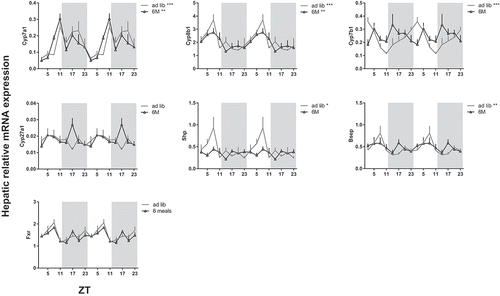Figures & data
Table 1. Primer sequences for PCR on liver tissue.
Table 2. Acrophase (ZT) and circadian rhythm in bile acid plasma concentration and hepatic expression of the bile acid biosynthetic pathway in experiment 1.
Figure 1. Plasma bilogram in rats: effect of timing of food intake on daily plasma bile acid concentrations. Food was available 24 h ad lib (left column), 10 h during the dark period (dark fed, middle column) or 10 h during the light period (light fed, right column). Grey background indicates the dark period and time is shown as ZT. p values are given for statistical significant rhythms as tested by JTK software. BA: bile acids; t: taurine; g: glycine. Note the differences in Y-axis scaling.
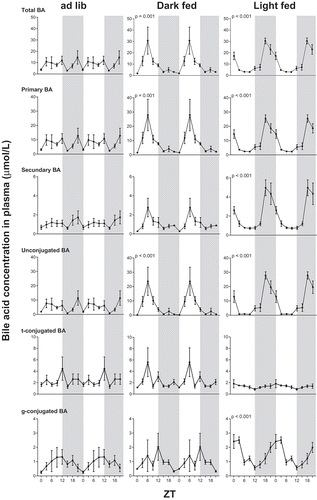
Figure 2. Effect of timing of food intake on hepatic mRNA expression of biosynthetic bile acid genes. Rats were fed a chow diet time-restricted during the dark period (dark fed, filled circles) or light period (light fed, open circles) or 24 h ad lib (grey line). Grey background indicates the dark period and the X-axis the ZT. Rats were killed and liver tissue was collected for qPCR every three hours during 24 h. Gene expression is given relative to the geometric mean of three reference genes. Asterisks indicate if the expression pattern showed a significant daily rhythm, * p < 0.05, **p < 0.01, ***p < 0.001. Cyp: cytochrome P450 family member; Shp: short heterodimer partner; Fxr: farnesoid X receptor; Bsep: bile salt export pump.
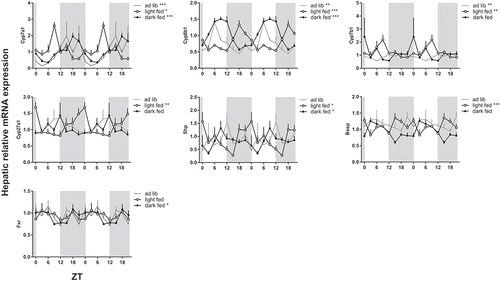
Figure 3. Effects of food composition and food timing on daily plasma bile acid concentrations and pool composition. (A) Plasma bile acid levels show a significant daily rhythm during time-restricted HFHS (filled squares) or HF (open squares) diet during the light (L) or dark (D) phase, similar to time-restricted rats on a chow diet (). Asterisks indicate the p values for statistical significant rhythms as tested by JTK software. (B) A high-fat diet increased the amount of glycine-conjugated bile acids and decreased the amount of taurine-conjugated bile acids compared to rats fed a chow diet (for statistics see Supplemental Figure S4), whereas the total amount of plasma bile acid concentrations did not change. (C) The relative amount of secondary bile acids is increased with a high-fat diet, especially in the light-fed animals (for statistics see Supplemental Figure S5), whereas the absolute amount of primary and secondary bile acids (BA) does not change with diet. *p < 0.05, **p < 0.01, ***p < 0.001.
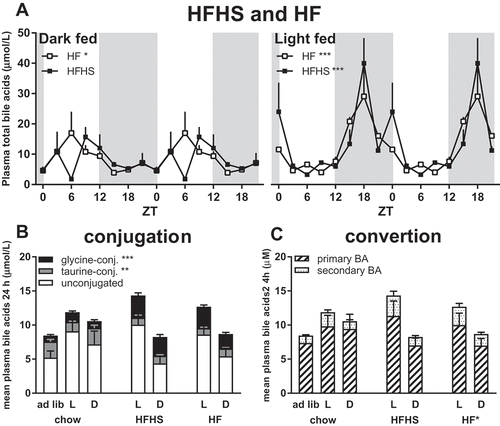
Figure 4. Effects of food composition on hepatic mRNA expression of biosynthetic bile acid genes. Gene expression is given relative to the geometric mean of three reference genes. Grey background indicates the dark period. Time is indicated on the X-axis as ZT. Cyp: cytochrome P450 family member; Shp: short heterodimer partner; Fxr: farnesoid X receptor; Bsep: bile salt export pump.
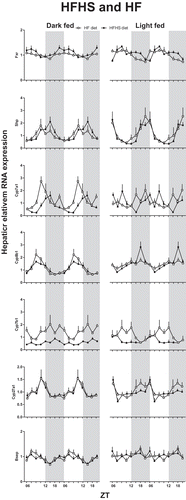
Table 3. Acrophase (ZT) and circadian rhythm in the hepatic expression of the bile acid biosynthetic pathway in experiment 2.
Figure 5. Effect of timing of food intake on daily hepatic mRNA expression of clock genes. Chow was available either 24 h ad lib (ad lib, grey line) or 10 h time-restricted during the dark phase (dark fed, filled circles) or light phase (light fed, open circles). Gene expression is given relative to the geometric mean of three reference genes. Grey background indicates the dark period and time is given as ZT. Asterisks indicate if expression rhythms show a significant daily rhythm as tested by JTK software (Supplemental Table S1), **p < 0.01, ***p < 0.001. Cry: cryptochrome; Dbp: albumin D-box binding protein; Rev-erbα: reverse viral erythroblastosis oncogene product α.
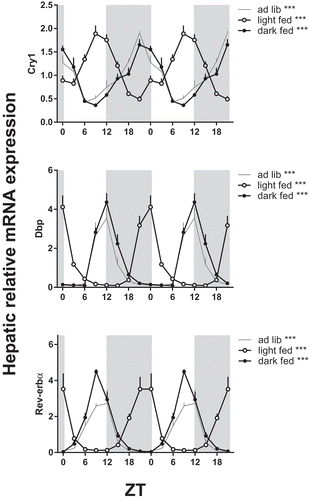
Figure 6. Effect of a 6 meals-a-day feeding schedule on daily hepatic mRNA expression of clock genes. Rats were fed a chow diet with food available every 4 h for 11–12 min (6M, open triangles) or 24 h ad lib (grey line) for 6 weeks. Gene expression is given relative to the geometric mean of three reference genes. Grey background indicates the dark period and time is given as ZT. Asterisks indicate if expression rhythm was significantly circadian as tested by JTK software (Supplemental Table S1), *p < 0.05, *** p < 0.001. Cry: cryptochrome; Dbp: albumin D-box binding protein; Rev-erbα: reverse viral erythroblastosis oncogene product α.
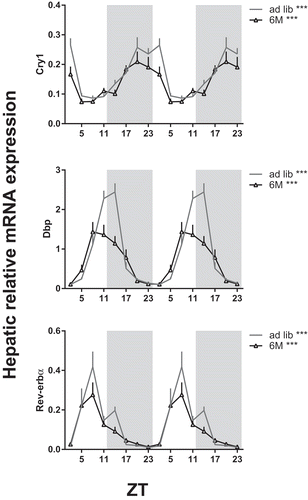
Figure 7. Effect of a 6 meals-a-day feeding schedule on daily hepatic mRNA expression of biosynthetic bile acid genes. Rats were fed a chow diet with food available every 4 h for 11–12 min (6M, open triangles) or 24 h ad lib (grey line). Gene expression is given relative to the geometric mean of three reference genes. Asterisks indicate if an expression rhythm showed a significant daily rhythm as tested by JTK software, *p < 0.05, **p < 0.01, ***p < 0.001. Grey background indicates the dark period and time is given as ZT. Cyp: cytochrome P450 family member; Shp: short heterodimer partner; Fxr: farnesoid X receptor; Bsep: bile salt export pump.
